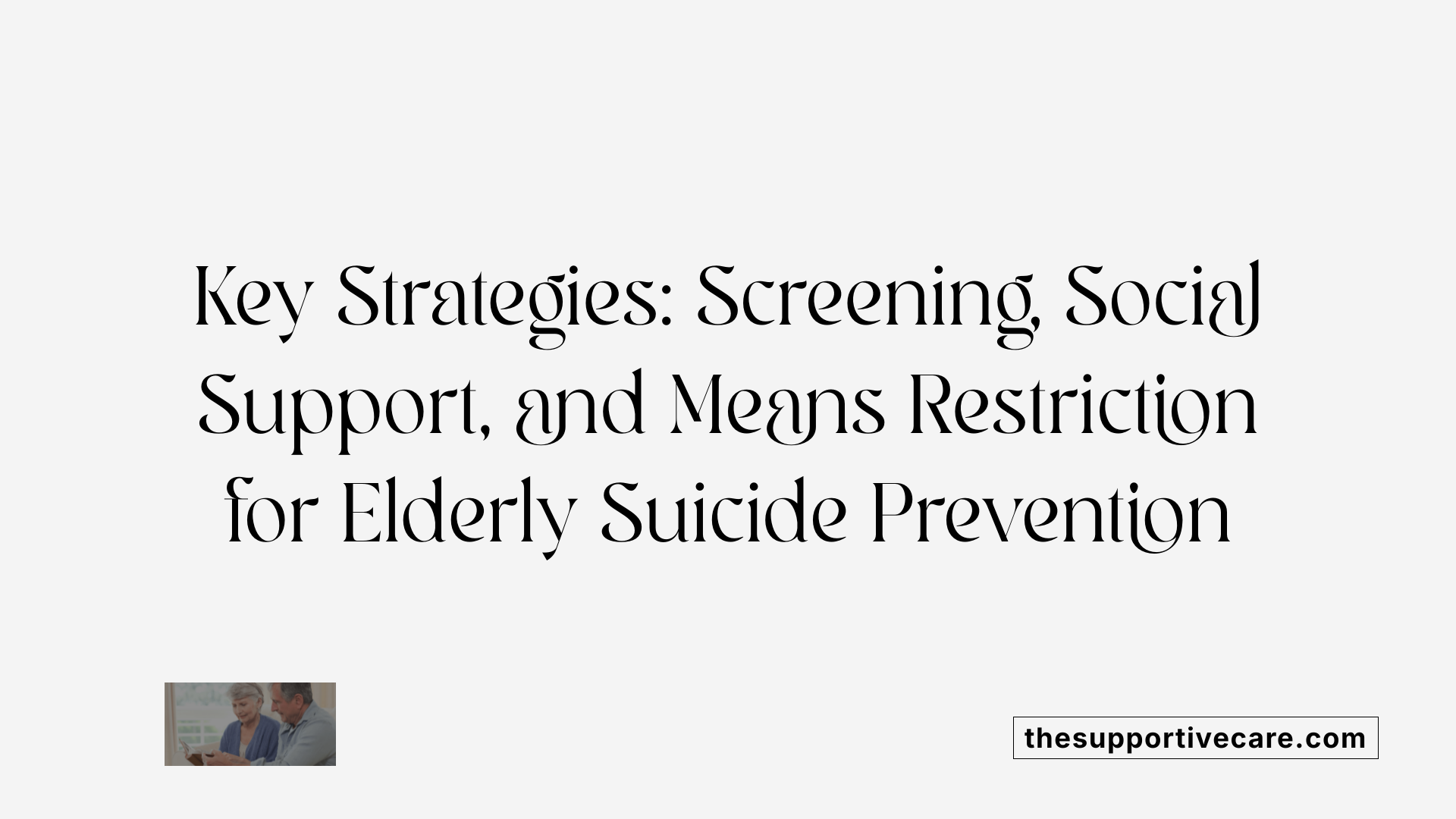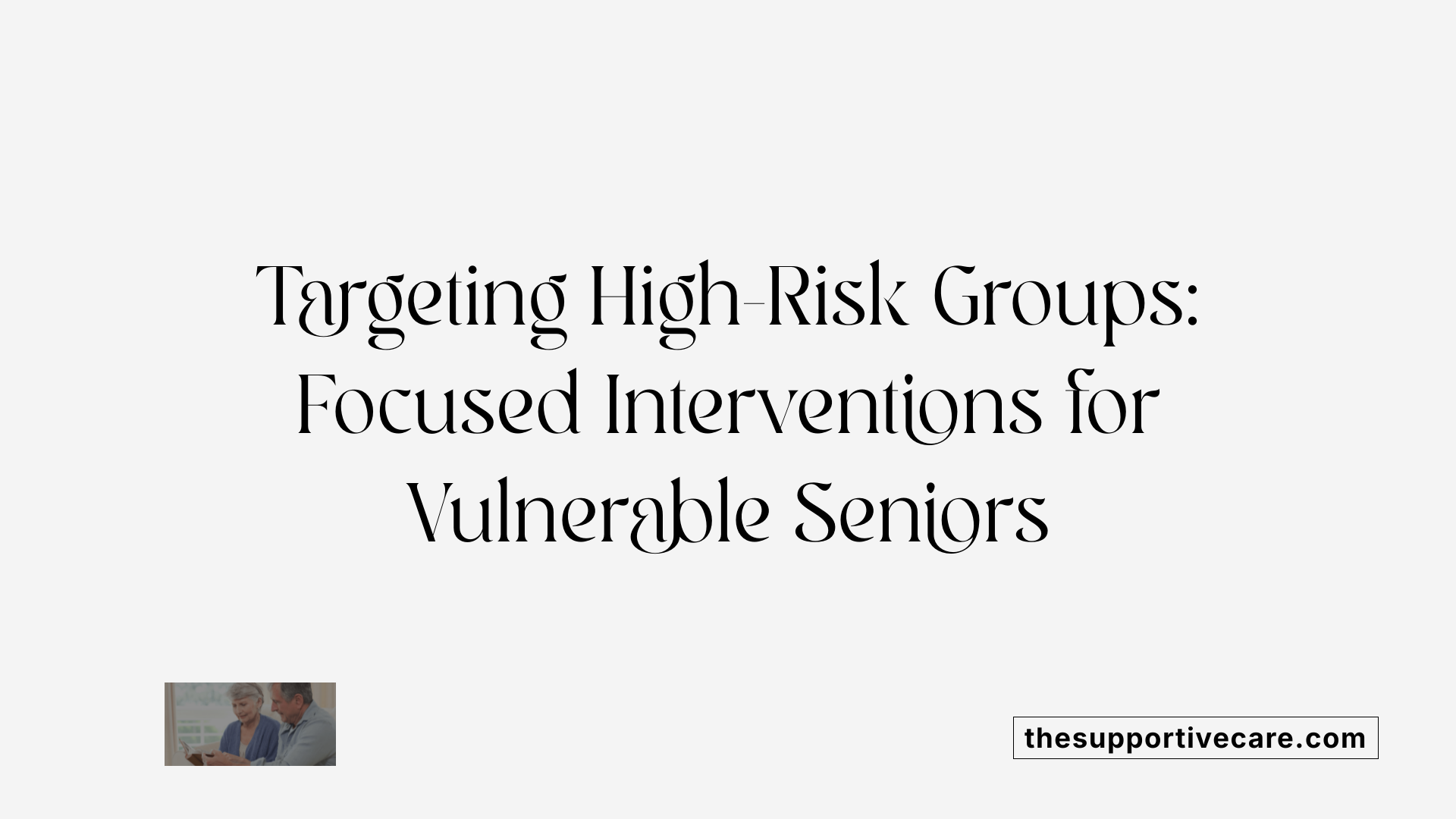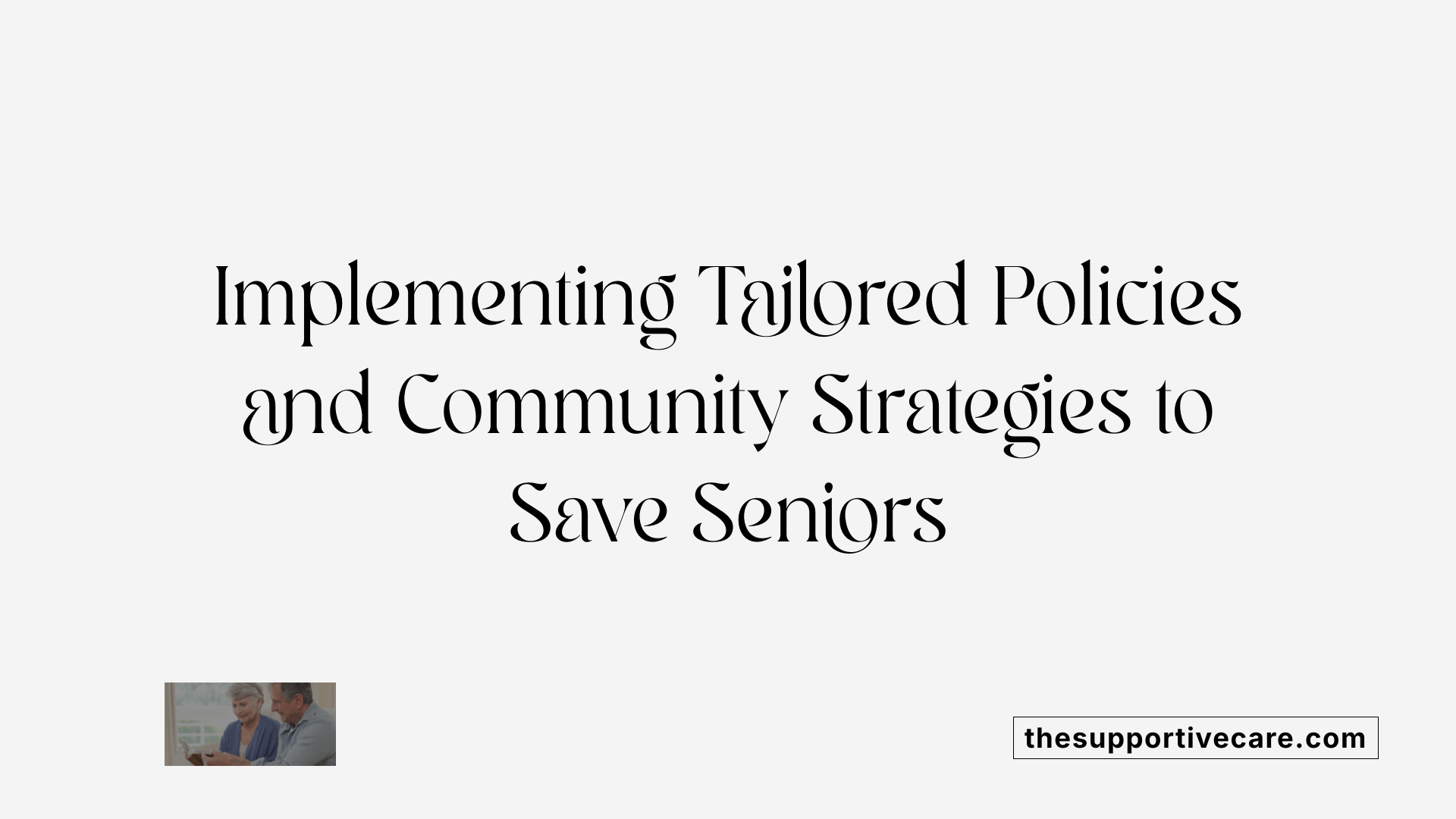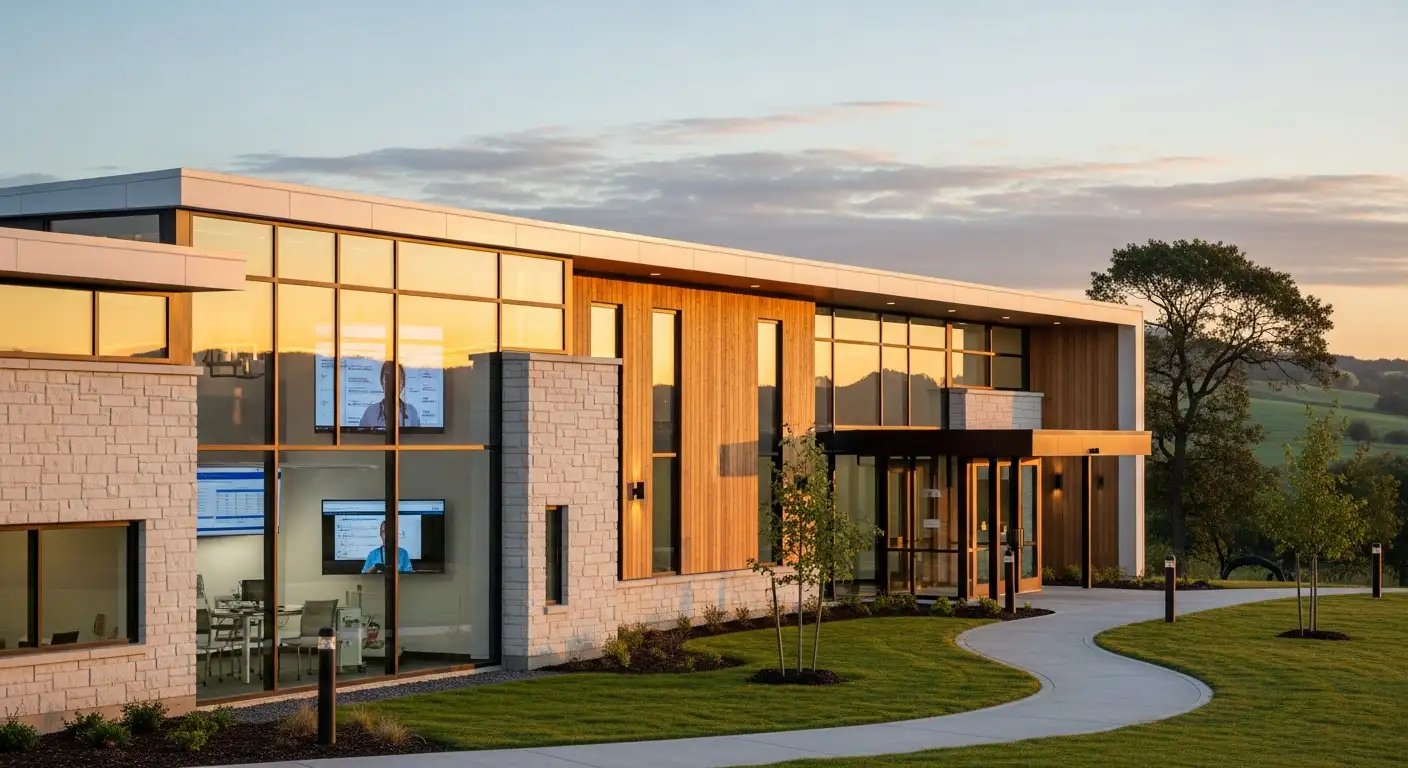Understanding the Critical Need for Senior Suicide Prevention
As the senior population grows rapidly, so does the importance of targeted suicide prevention strategies. Older adults, especially those over 65, face unique risks and challenges that increase their vulnerability to suicide. Addressing these issues comprehensively through community programs, policy development, and individual interventions is essential for reducing mortality rates and improving quality of life among seniors.
Overview of Senior Suicide Prevention Strategies

What are effective suicide prevention strategies tailored for the senior population?
Effective suicide prevention approaches for older adults focus on early identification of mental health conditions like depression and anxiety, which are significant risk factors. Routine screening with validated tools such as the Geriatric Depression Scale (GDS) or PHQ-9 helps detect at-risk individuals promptly. Ensuring access to evidence-based treatments, including psychotherapy like Cognitive Behavioral Therapy (CBT) and collaborative care models such as IMPACT, supports mental health recovery. Community engagement plays a crucial role; programs that foster social connections, such as senior centers, peer support groups, and community activities, effectively combat loneliness—a core contributor to suicidal ideation. Caregiver and gatekeeper training enhances their ability to recognize warning signs like withdrawal, mood swings, or giving away possessions. Crisis resources, notably the 988 Suicide & Crisis Lifeline, provide immediate support. Safety planning, which involves developing coping strategies and identifying sources of support, offers a structured response to emergent risks. Policies promoting means restriction, especially firearm safety measures, significantly lower access to lethal methods. These combined efforts form a comprehensive and tailored approach for senior suicide prevention.
The Rising Urgency: Suicide in the Aging Population

What are the risk factors and warning signs indicate a higher risk of suicide in older adults?
Risk factors for suicide among older adults include mental health issues, such as depression, anxiety, bipolar disorder, and schizophrenia, which often go undiagnosed or untreated in this age group. Chronic health conditions like serious illnesses, persistent pain, and cognitive impairments significantly increase vulnerability. Social factors, especially loneliness, social isolation, grief from recent losses, and feeling like a burden to others, heighten the risk. Access to lethal means, particularly firearms and toxic substances, further exacerbates danger. A history of prior suicide attempts or a family history of suicide also elevates risk. Warning signs to watch for include withdrawal from social activities, giving away personal possessions, expressing hopelessness or feeling like a burden, sudden changes in mood or behavior, sleep disturbances, and verbalizations about death or dying. Early recognition of these factors is vital for effective intervention.
How does the suicide rate among older adults compare to other age groups?
Older adults, especially those aged 65 and above, have the highest suicide rates of any age group. The rate among those over 75 is particularly elevated, with men in this age group experiencing the highest overall suicide rates nationally. For example, the suicide rate for individuals aged 70 and older is nearly twice that of teenagers aged 15-19. Despite only comprising about 16.8% of the U.S. population, seniors account for about 22% of all suicides. A stark gender disparity exists: approximately 83% of suicides among older adults are performed by men, who are more likely to use highly lethal methods such as firearms. This preference for lethal means contributes to higher completion rates; in fact, one in four older adults who attempt suicide succeed, compared to just one in 200 youths.
What are the long-term trends in senior suicide rates, and how might demographic shifts influence future risk?
The trend of rising suicide rates among older adults is evident over recent years. In 2022, there was an over 8% increase in the suicide rate among those aged 65 and over compared to the previous year. The rates continue to climb among individuals over 85, who face the highest risk. Looking ahead, demographic shifts, particularly the aging of the Baby Boomer generation, suggest these trends may worsen. As Baby Boomers reach their 70s and 80s, factors such as increased prevalence of chronic health conditions, loneliness, loss of independence, and financial hardships are expected to elevate risk levels further. Such projections highlight the urgent need for targeted prevention strategies tailored to the aging population, to mitigate the rising toll of suicide.
What specific high-risk groups within the senior population should targeted interventions focus on?
Interventions should prioritize groups within the older adult population that are at greatest risk. Men aged 75 and older face the highest incidence of suicide, with rates significantly surpassing those of women in the same age bracket. Individuals living alone or experiencing social isolation are particularly vulnerable, as loneliness is a significant contributing factor. Seniors coping with chronic illnesses such as arthritis, heart disease, or cognitive decline require special attention, as these conditions often correlate with depression and suicidal thoughts. Minority seniors, especially white elders with limited access to healthcare and mental health services, also represent a crucial subgroup needing culturally sensitive interventions. Additionally, seniors experiencing recent major life changes—bereavement, loss of independence, or financial strain—should be prioritized for screening and support efforts. Tailoring programs to these specific groups can significantly reduce the incidence of suicide in this vulnerable population.
Community and Policy-Level Interventions for Elderly Suicide Prevention

What policy development and strategic planning are essential for effective senior suicide prevention?
Effective senior suicide prevention requires comprehensive policy development based on strategic planning. This approach starts with data-driven assessment of the problem, including the identification of specific risk and protective factors in older adults.
Policy needs to set clear goals that focus on tailored interventions such as routine mental health screening, development of safety plans, and restricting access to lethal means like firearms and medications. Special consideration should be given to issues common among seniors, including social isolation and physical health challenges.
Ongoing evaluation and adjustments are critical to adapting prevention efforts to emerging needs and new evidence. Training healthcare providers, caregivers, and community members in recognizing warning signs and providing support is essential.
Furthermore, policies must incorporate resources such as crisis hotlines—like the 988 Suicide & Crisis Lifeline—and promote safe environments. This includes efforts to improve mental health care access, especially in rural or underserved communities, and to ensure environments limit lethal means access, contributing to a comprehensive safeguard for older adults.
Overall, the development of effective policies hinges on multi-sector cooperation, continuous research, and a focus on building a supportive community framework that addresses the holistic needs of the elderly population.
Can you provide examples of successful senior-focused suicide prevention efforts or case studies?
Numerous community-based and clinical programs globally have demonstrated success in reducing suicide among older adults. In Japan, initiatives like mental health workshops combined with depression screening and social support outreach have led to significant drops in suicide rates. These efforts often emphasize early intervention and community engagement.
Integrated mental health services, which include short-term pharmacotherapy and psychotherapy tailored to older adults, have shown high remission rates of depression and reduced suicidality.
Specialized activities targeting known risk factors like social isolation and physical illness include interpersonal psychotherapy, goal-setting workshops, and resilience programs. These are designed to strengthen social bonds and improve mental health.
Gender-specific strategies have also shown promise, especially those that encourage help-seeking among men, who traditionally have higher suicide rates.
Initiatives like the Arkansas Comprehensive Suicide Prevention program exemplify structured, multi-sector strategies involving community partnerships, education, mental health service expansion, and access barriers reduction. These examples highlight the importance of coordination between healthcare providers, social services, and community organizations to effectively reduce elder suicide risk.
More Information
To deepen understanding and discover more effective strategies, search queries such as "Senior community programs," "policy initiatives on elderly mental health," "social integration efforts," "elder suicide case studies," "funding for senior mental health," "cross-sector collaboration for elder prevention," and "elder mental health workforce training" can provide valuable insights and current initiatives. These resources support ongoing development and implementation of impactful suicide prevention efforts tailored for older adults.
| Aspect | Examples | Additional Notes |
|---|---|---|
| Policy and Planning | Data analysis, tailored mental health policies | Focus on social isolation, health status, lethal means restriction |
| Community Programs | Outreach, depression screening, social activities | Reduces isolation and builds support networks |
| Clinical Interventions | Short-term therapy, medication management | Addresses depression, chronic pain, medical comorbidities |
| Program Success Cases | Japan’s mental health outreach, Arkansas’s multi-sector strategies | Demonstrate effective coordination and tailored approaches |
| Funding & Workforce | Training for health providers, eldercare staff | Ensures capacity to recognize and support at-risk seniors |
Addressing elder suicide requires an integrated approach that combines policies, community actions, clinical services, and continuous evaluation. Success stories serve as models for expanding these efforts nationwide and adapting them to local needs.
The Collective Role in Protecting Our Seniors
Preventing suicide among older adults is a complex challenge that demands coordinated efforts across healthcare, community organizations, policymakers, and the public. Strategies rooted in evidence-based practices, reinforced by education and awareness initiatives, and supported by robust community and policy frameworks are vital. Investing in mental health services, reducing access to lethal means, and strengthening social connections can save lives and enhance well-being. As the senior population continues to grow, so must our commitment to implementing holistic, inclusive approaches that honor the dignity and resilience of our elders and ensure a safer, more supportive environment for a dignified aging process.
References
- Suicide Prevention | Florida Department of Health
- Suicide and Older Adults: What You Should Know
- Interventions to Prevent Older Adult Suicide: Final Report
- Suicide Warning Signs and Prevention Strategies for Older ...
- Fostering Connection and Belonging to Prevent Suicide ...
- Learning Center
- Addressing Suicide in the Older Population




































































































